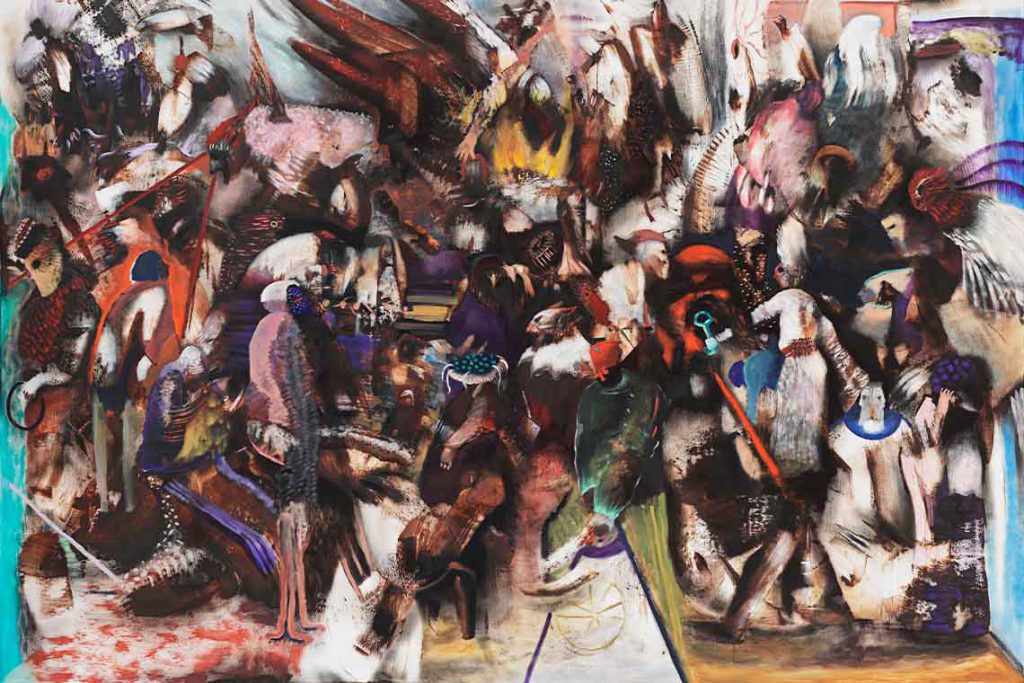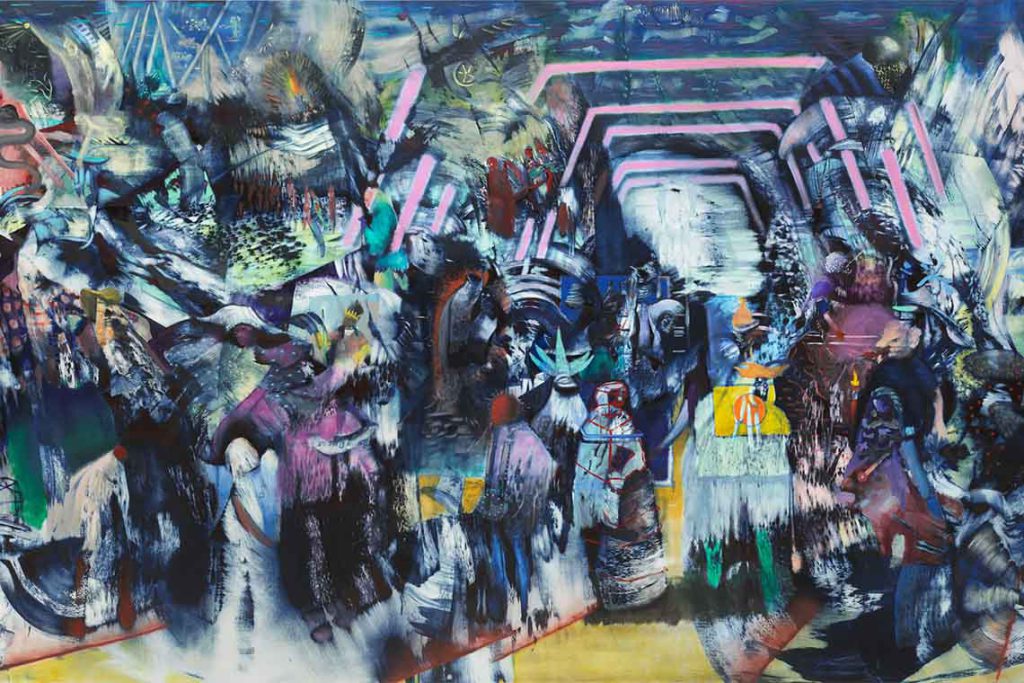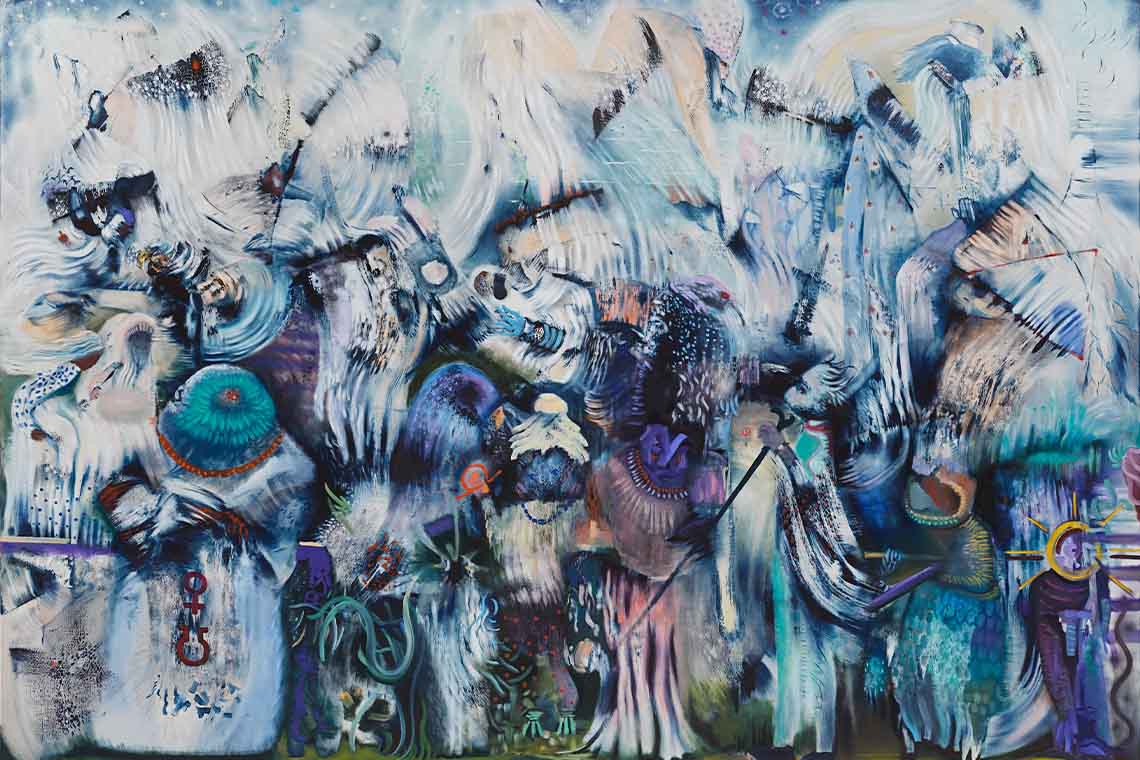Ali Banisadr’s solo show The Changing Past at Victoria Miro in London reflects on the artist’s complex and layered approach to works that explore the essence of conflict and instability.
There is a large plate-glass window at the deepest end of the Victoria Miro gallery in London. Beyond it is a confined extract of the city, mullions subdividing a flatness of early-autumn trees and apartments looking back. It is not, it must be said, particularly exciting.
There are, however, many other windows around the space, each offering far more enticing fractal views – not into the immediate London beyond, but upon a plethora of places and times, both real and imaginary. These paintings, forming Ali Banisadr’s first solo exhibition with the gallery since joining two years ago, are collectively titled The Changing Past and act as portals into artistic and political histories, as well as the artist’s personal story.
Born in Tehran in 1976, Banisadr was three years old when the Iranian revolution took place, and four at the start of the Iran-Iraq war. Too young to express himself verbally or understand parental explanation, he turned to the visual in order to process and express the surrounding destabilisation. At such a young age, these primal experiences of bombs, sirens, fear, vibrations and threats had to be filtered through his brief understanding of the world – the artist has spoken of memories from this period as a mix of abstract and recognisable images, an early recognition of his synaesthesia.
Years later, when Banisadr was twelve, his parents moved the family to California by way of Turkey, and he has remained in the USA since, studying his BFA and MFA in New York City, where he now resides. His works, however, are somewhat placeless and timeless, each canvas taking the mind into disparate geographies, as well as both forward and back in time.

Is time an arrow or a wheel? the artist asks through the title of a 2023 painting, a question also literally written into the painting in small letters placed centrally at the bottom, under a line-drawn symbol of a wheel with eight spokes. In the top right corner, the question is suggested again but is now abbreviated to a left-facing arrow, the letter t, then another small wheel made of simple lines. The rest of the canvas is chaos, but with underlying order. The longer one investigates, more hidden forms and characters secreted within its gestural movement keep the eye busy, trying to find logic and meaning, unable to settle – perhaps akin to a child’s fear of bombs landing all around. Here we are, four decades later, still in times of turmoil with no let-up in human violence, with Banisadr maybe questioning notions of progress, presenting history, place, culture and peoples as compounded and intermingled layers in an ever-complex repeating motif of destruction.
While on his MFA, Banisadr visited the landscapes of Normandy, once sites of Second World War devastation. Their scars – both in nature and culture – have softened with time, but the artist could read the place deeper, seeing in it childhood memories of Tehran. He has described a 2006 painting made in response – a visceral explosion in the middle of a smudged, muddy colour field – as opening a new way for him to think of his craft, connecting his young trauma with adult readings of the world around him, and learning to paint from recollections of vibrations, noise and unfathomable fear.
He titled that painting The Waste Land, and T S Eliot’s poem with its fragmentation of place and time into a collage of humanity and destruction has been one of many recurring references. It finds its way into this exhibition 17 years later, an Eliot phrase providing the title to the largest exhibited canvas. These fragments I have shored against my ruins (2023) is a 4.5-metre-wide Boschian amalgam of figures and symbols, with abstract sweeps washing them all together. On the right-hand side, a figure who might well be Tiresias, the Greek prophet and narrator of Eliot’s collage poem who saw truth through his blindness, appears to be departing the scene.

This vast canvas is a wasteland itself, one which like Eliot’s poem draws the mind deeper into complexity, though reveals few solutions. Like Normandy’s landscapes, more complexity is added on top of the last layer, compressing trauma into the foundations of that which follows. Another painting, Queen of the Night (2022), with brushstrokes that shape the canvas as a river’s current, reveals itself at the surface and also speaks to this overpainting of memory and meaning. Formed of transhistorical motifs, it draws its name from a plaque in the British Museum which was once named the Burney Relief. The 50-cm-tall terracotta work originated in southern Mesopotamia and has been dated to c.1750 BCE, but its precise provenance and history, and the context of its discovery, remain unknown.
The painting is full of figures, though all seem to belie recognition. Two owls from the historic relief seem to have found their way into Banisadr’s crowd of characters, but transmogrified and distorted from their original clarity. Fragments of the nighttime queen can perhaps be found, and hunting for her turns into a game, but one that can’t lead to conclusion. As my eye hunts the bewildering scene, I wonder if this is a process which can never end, but only repeat – new layers of meaning trapped into the paintings with each viewing.



